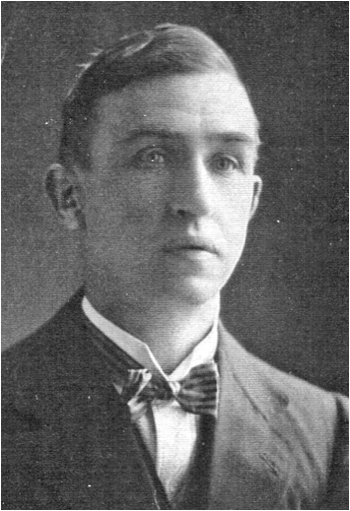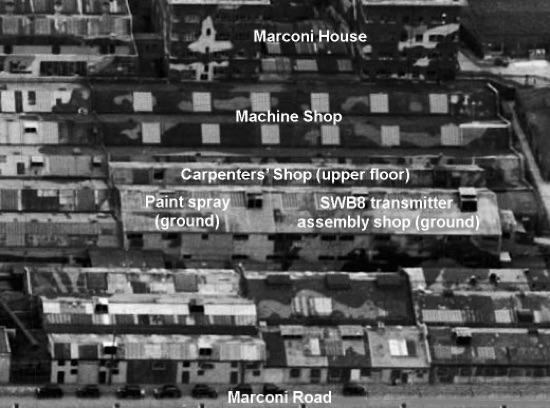William Henry Scotchman was born in Chelmsford in 1878, married in Enfield in 1900 and had four children. He worked as a railway fireman before returning to Chelmsford when he worked at Marconi's. He was killed in an air raid on the factory in May 1941.
William Henry SCOTCHMAN, Civilian
Killed in an air raid on Marconi's works, New Street, Chelmsford. Aged 62
During the day, whilst clearing up operations continued at the factory, a worker reported hearing tapping sounds from beneath the debris of the wrecked paint spray and transmitter erection shops. Immediately, workmen with crowbars and shovels began frantic attempts to locate the source of the sounds but despite their efforts no one could be found and it was decided to terminate any further rescue work as it was concluded that anyone still buried would be dead by then.
On the following day, Saturday 10th May, the large pile of debris was cleared and somewhat alarmingly the source of the tapping sounds was clear to be seen by all - a third 500 Kg delayed action high explosive bomb, lay there unexploded but still ticking. Its serial number Ex 536 could be clearly seen. The Bomb Disposal Squad was immediately called in and the factory and surrounding streets were evacuated. Such was the nature and position of the device that the B.D.S. were forced to detonate the bomb where it lay. A warning was put out to this effect, and at 10.30 a.m. on Monday 12th May the bomb was exploded in situ. Further damage was inflicted to the factory, but fortunately there were no further casualties.
The fourth bomb, a 250 Kg. high explosive, narrowly missed the Marconi works and fell onto houses in Marconi Road, where two people received fatal injuries. A terrace of six houses near the junction with Bishop Road suffered most as a result, with three demolished (nos. 70, 72 & 74) and two others believed damaged beyond repair (nos. 76 & 78). The sixth house, no. 80, was seriously damaged as were five others (nos. 62, 64, 66, 68 & 82). The combined effects of blast from all four bombs affected around 375 other properties within a quarter of a mile radius with damage mainly confined to windows, doors, roofs and ceilings.
William's funeral was took place on 16th May 1941 at St. Michael's Galleywood, where he is remembered on the village’s war memorial.
William left an estate valued at £736 17s 8d with probate granted to his widow, who died in 1949.
110613

William Henry Scotchman was born in Chelmsford in 1878, the son of another William Henry Scotchman.
He married Louisa Dinah Barton on 20th March 1900 at St. Andrew's Church, Enfield, Middlesex. They had three daughters: Lilian May Scotchman (born in 1901), Hilda Louisa Scotchman (born in 1903), and Ivy W. Scotchman (born in 1911) and a son, William Henry Scotchman (born and died in 1913).
The 1901 census listed 22 year-old William, his wife and eldest daughter at 35 Fifth Avenue in Enfield. William was a railway engine stoker. In 1911 the next census found 32 year-old William living with his wife and two daughters at 17 Albert Road in Leyton. He was a locomotive fireman for a railway.
By 1941 William was working for the Marconi Wireless Telegraph Co. Ltd. at their premises in New Street, Chelmsford, and living with his wife at The Firs in Galleyend.
William died on 9th May 1941, one of 17 workers killed when
his workplace was bombed in a skilled raid by the Luftwaffe. He was aged 62. A further 20 people were seriously injured and 18 others slightly hurt in the factory.
A red air raid warning had sounded the previous evening at 11.24 p.m. but all was quiet until 2.22 a.m. when an enemy Junkers Ju 88 approached the town. Eyewitnesses saw the raider clearly in the almost full moonlight, as it dived to within a few hundred feet of roof tops, released two bombs, circled and dropped two more, before rising rapidly and escaping towards the coast. The aircraft had in fact come so low that those who had seen it thought it likely to hit Chelmsford Cathedral's spire.
Three of the bombs which were dropped scored direct hits on Marconi’s, whilst another went astray and struck residential properties in Marconi Road which ran along the northern side of the factory. Marconi’s was an obvious target for the Luftwaffe. The New Street factory carried out vital work for several Government departments - designing, testing, developing and producing wireless instruments for the Admiralty, Air Ministry, Ministry of Supply and the Crown Agents.
Of the factory’s 3221 workers, some 390 were engaged on the night shift at the time of the raid. They had been on duty since 8.15 p.m. the previous evening and were due to finish at 7.30 a.m., with the day shift taking over fifteen minutes later. The air raid warning had interrupted work of the two hundred or so employees in the machine shop The men there had taken shelter behind an internal blast wall, whilst the women had gone to the strong rooms below the main office building
The bombs that hit Marconi’s fell at the western end of the main factory building. One, thought to have been a 250 kg. DH high explosive, exploded in the centre of machine shop which occupied the southern half of the building. Another, a 500 kg. DH high explosive, fell on its northern half, through the first floor carpenters’ shop and detonated on the floor of the SWB8 transmitter erection shop beneath it. This bomb ignited a drum of cellulose in the carpenters’ shop and the fire rapidly spread across debris into the neighbouring paint spray shop. There, dope was ignited and several men, who had survived the initial explosions, were trapped behind a blast wall and killed by the fire before rescuers could reach them. The fire was eventually brought under control by 5 a.m., though not before flames had spread to Ridley’s flour mill in neighbouring Townfield Street. Damage there was extensive with a very large number of roof slates lost, timbers charred and internal linings destroyed.
